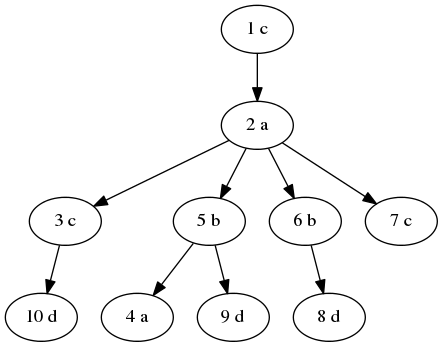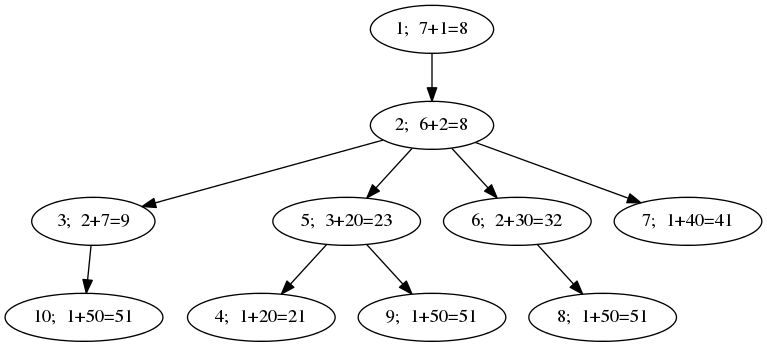Acyclic Organic Compounds
题意翻译
+ 给定一棵有 $n$ 个节点的有根树 $T$,每个节点从 $1$ 到 $n$ 被编号,根为 $1$,每个节点都有一个字符。
对于一个节点 $v$ 的子树,从 $v$ 到子树中某一个节点的路径上的字符可以组成一个字符串(可能只有一个字符),定义所有不同的字符串的个数为 $\operatorname{dif}(v)$。
并且,对于每个节点 $v$ 都有一个数值 $c_v$,求 $\operatorname{dif}(v)+c_v$ 的最大值,以及最大值的个数。
+ 第一行一个数 $n$ ($1\leq n\leq 3\times10^5$),表示树中节点的个数。
第二行 $n$ 个空格分隔的数 $c_i$ ($0\leq c_i\leq 10^9$)。
第三行一个小写英文字符组成的字符串,第 $i$ 个字符表示树上编号为 $i$ 的节点的字符。
接下来 $n-1$ 行描述了树的边。每一行给出两个用空格分隔的整数表示一条树边。
数据保证给出的是一棵树。
+ 输出两行,第一行输出 $\operatorname{dif}(i)+c_i$ 的最大值,第二行输出最大值的个数。
+ $1\leq n\leq 3\times10^5$,$0\leq c_i\leq 10^9$
题目描述
You are given a tree $ T $ with $ n $ vertices (numbered $ 1 $ through $ n $ ) and a letter in each vertex. The tree is rooted at vertex $ 1 $ .
Let's look at the subtree $ T_{v} $ of some vertex $ v $ . It is possible to read a string along each simple path starting at $ v $ and ending at some vertex in $ T_{v} $ (possibly $ v $ itself). Let's denote the number of distinct strings which can be read this way as .
Also, there's a number $ c_{v} $ assigned to each vertex $ v $ . We are interested in vertices with the maximum value of .
You should compute two statistics: the maximum value of  and the number of vertices $ v $ with the maximum .
输入输出格式
输入格式
The first line of the input contains one integer $ n $ ( $ 1<=n<=300000 $ ) — the number of vertices of the tree.
The second line contains $ n $ space-separated integers $ c_{i} $ ( $ 0<=c_{i}<=10^{9} $ ).
The third line contains a string $ s $ consisting of $ n $ lowercase English letters — the $ i $ -th character of this string is the letter in vertex $ i $ .
The following $ n-1 $ lines describe the tree $ T $ . Each of them contains two space-separated integers $ u $ and $ v $ ( $ 1<=u,v<=n $ ) indicating an edge between vertices $ u $ and $ v $ .
It's guaranteed that the input will describe a tree.
输出格式
Print two lines.
On the first line, print  over all $ 1<=i<=n $ .
On the second line, print the number of vertices $ v $ for which .
输入输出样例
输入样例 #1
10
1 2 7 20 20 30 40 50 50 50
cacabbcddd
1 2
6 8
7 2
6 2
5 4
5 9
3 10
2 5
2 3
输出样例 #1
51
3
输入样例 #2
6
0 2 4 1 1 1
raaaba
1 2
2 3
2 4
2 5
3 6
输出样例 #2
6
2
说明
In the first sample, the tree looks like this:
The sets of strings that can be read from individual vertices are:
Finally, the values of  are:
In the second sample, the values of  are $ (5,4,2,1,1,1) $ . The distinct strings read in $ T_{2} $ are ; note that  can be read down to vertices $ 3 $ or $ 4 $ .